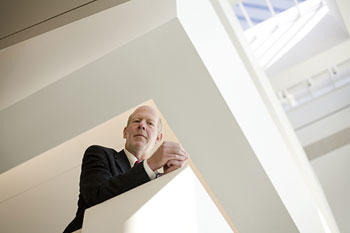COVER STORY
Structures of life: Ever more complex buildings are crucibles of ideas and innovation
(Page 2 of 5)"Each of these top schools is competing for the best faculty, postdocs and students," Emr said. And these mega-research buildings are not limited to universities. New York City's Memorial Sloan-Kettering Cancer Center, the world's oldest and largest private cancer center, nearly doubled the size of its research facilities in 2006 with the opening of the Mortimer B. Zuckerman Research Center building as the first part of a $503 million research complex.
This is "a very exciting time in biomedical research," Emr said in explaining the building boom. "Universities and biotech companies are making key discoveries of novel targets for the development of new therapeutics that will more effectively treat devastating diseases like cancer, Alzheimer's disease and AIDS."
Design fosters a collaborative culture
With the opening of Cornell's Weill Hall and the Weill Institute for Cell and Molecular Biology, Cornell has been able to recruit talented new faculty members and retain many of its top research scientists. Weill Hall's goal of facilitating interdisciplinary research is intrinsic to its design, exemplified by the open labs that run the length of each floor of the building's south wing as well as one floor of the north wing.

Chris Fromme, assistant professor of molecular biology and genetics. See larger image
Chris Fromme, a new assistant professor who studies the relationships between structure and function of proteins, has a lab that ends where Emr's lab begins. As a result, he already has become familiar with two of Emr's postdocs.
"I'm only a few months removed from being a postdoc myself," said Fromme, who hails from the University of California-Berkeley. "Within two weeks of being here I already had two collaborations with these postdocs, and that is pretty remarkable."
"We wanted a facility that was going to foster collaboration and innovations and creativity that we didn't think about 10 years ago," said Stephen Kresovich, Cornell's vice provost for the life sciences. "In the long run, we'll be measured by how this building, as a keystone, impacts all of life sciences at Cornell."
Cornell's New Life Sciences Initiative has always involved innovation by researchers from various disciplines working together. That's why faculty planners decided to place parts of different departments on the same floor. The Weill Institute, the Department of Biomedical Engineering, a business incubator scheduled to open later this year and select faculty and students from the Department of Biological Statistics and Computational Biology and the Division of Nutritional Sciences all share the building, spreading out across four floors.
Another forward-thinking feature of the building is its gold rating under the U.S. Green Building Council's Leadership in Energy and Environmental Design program (see sidebar, p. 17).
"This is the beginning of an experiment, and I am excited about the opening," said Kresovich. "But I'd also be excited to come back in 50 years to see how it turns out."

Stephen Kresovich, vice provost for the life sciences. See larger image
The ultramodern building's two-acre basement includes a low-vibration space built on separate floor plates for imaging research; a 20,000-square-foot vivarium;
$3 million worth of controlled-environment chambers for plant research; and tunnels to the Plant Science and Biotechnology buildings. The basement also holds a centralized glass washroom that makes such mundane but essential activities as cleaning and sterilizing lab ware more efficient.